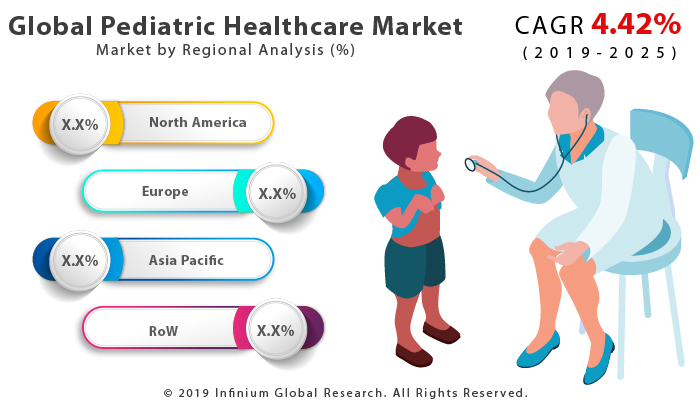Pediatric Healthcare Market (Type - Chronic Illness, and Acute Illness; Indication - Cardiac Disorders, Metabolic Disorders, Asthma and Allergies, Genetic Disorders, and Other Indications; Treatment - Immunotherapy, Surgeries, Medications, and Other Treatments): Global Industry Analysis, Trends, Size, Share and Forecasts to 2025
A recent report published by Infinium Global Research on pediatric
healthcare market provides in-depth analysis of segments and sub-segments in
the global as well as regional pediatric healthcare market. The study also
highlights the impact of drivers, restraints, and macro indicators on the
global and regional pediatric healthcare market over the short term as well as
long term. The report is a comprehensive presentation of trends, forecast and
dollar values of the global pediatric healthcare market. According to the
report, the global pediatric healthcare market is projected to grow at a CAGR
of 4.42% over the forecast period of 2019-2025.
Market Insight
Pediatric healthcare is a branch of medicine which deal with the
treatment of infants and children or child-related diseases. It is mainly
involved in vaccines, drugs, and nutritional the purpose behind that is helping
for the healthy growth of children. The age range for pediatric healthcare is
from birth up to 7 years. Several patients die due to disease, virus, and
malnutrition each year. Many children suffer from gastrointestinal,
respiratory, and other chronic diseases due to lower immunity. Owing to the pediatric
healthcare study is quite significant.
The global pediatric healthcare market is primarily driven by the
rising demand for injury and Diarrhea and related disease, chronic disease
treatment in children. Moreover, growing the prevalence rate of child or
pediatric diseases, changes trend in childcare is expected to fuel the market
growth in the near future. However, pediatric diseases are various on the basis
of long-term to short term treatments which required a lot of time which can
endeavor economic pressures on the parents are expected to hinder the demand for
the global pediatric healthcare market. Nonetheless, increasing the count of the
patient and rising government efforts to raise awareness in people for
pediatric treatments and disorders are anticipated to create a new opportunity
for the global pediatric healthcare market.
On the basis of region, the global pediatric healthcare market is
bifurcated into North America, Asia Pacific, Europe, Latin America, and the
Middle East and Africa. North America held the largest revenue share for the
global pediatric healthcare market in 2018 owing to in the region various
pharmaceutical companies are launching new drugs for pediatric patients and
treatment. The Asia Pacific is anticipated to grow at substantial growth rate
during the projected years on an account of rising in the count of children
with disorders and diseases and growing health care infrastructure in emerging
economies including India, Indonesia, and China.

Segment Covered
The report on global pediatric healthcare market covers segments
such as type, indication, and treatment. On the basis of type, the sub-markets
include chronic illness, and acute illness. On the basis of indication, the
sub-markets include cardiac disorders, metabolic disorders, asthma and
allergies, genetic disorders, and other indications. On the basis of treatment,
the sub-markets include immunotherapy, surgeries, medications, and other
treatments.
Companies Profiled:
The report provides profiles of the companies in the market such
as GlaxoSmithKline, Pfizer, Pediapharm, Merck, AstraZeneca, Boehringer
Ingelheim, Sanofi, Eisai, Mylan, and Gilead Sciences.
Report Highlights:
The report provides deep insights into the demand forecasts, market trends, and micro and macro indicators. In addition, this report provides insights into the factors that are driving and restraining the growth in this market. Moreover, The IGR-Growth Matrix analysis given in the report brings an insight into the investment areas that existing or new market players can consider. The report provides insights into the market using analytical tools such as Porter's five forces analysis and DRO analysis of pediatric healthcare market. Moreover, the study highlights current market trends and provides forecast from 2019-2025. We also have highlighted future trends in the market that will affect the demand during the forecast period. Moreover, the competitive analysis given in each regional market brings an insight into the market share of the leading players.
